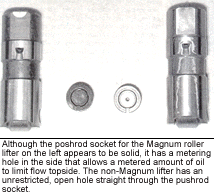OK! Lots of questions answered, thanks to Sireland67's lifters:
From top to bottom:
- A passenger's side lifter from the LA 360 - one of the "squirters"
- A random driver's side lifter from the LA 360; could have dribbled or not pumped up; no idea.
- Sireland67 lifter - this one wasn't pumping up in the cylinder #2 intake bore
- Sireland67 lifter - this one was dribbling, but pumped up correctly, and was in the cylinder #2 exhaust bore. The pushrod socket is shown face-out here (unlike #1 through #3, which are inverted to show the inside).
First - it didn't take long to figure out why lifter #3 wouldn't pump up. When I pulled it from the engine, it started leaking from the oil input hole, so I knew the check valve was stuck open.
When I opened it up, I found the plunger jammed at the bottom of the lifter. No amount of yanking with extraction tools made it budge - which included trying to extract the plunger while pressing the check ball down with a paper clip, and beating the living hell out of it on a piece of wood. The plunger is in there forever.
So, no plunger to see there.
The second of Sireland67's lifter came apart with no issue, which brings us to the almighty LA-vs-Magnum pushrod socket difference. LA straight-through oiling style at top, Magnum side-oiler at bottom:
So THAT's what the Mopar1 site was referring to all this time. I'll be damned if I was expected to understand this from a little grainy picture that didn't even show the hole (description or not). This also explains the slow speed at which these pump up with oil - no doubt, that's how they're supposed to work.
So...
No question about it, both batches of 8 lifters in my engine, working or not, are LA-roller style, not Magnum. The 90-degree oil inlet may or may not be associated with the LA style as well (seeing as it is reflected on two different styles of obviously LA-roller lifters).
At any rate, I'm very sure of the following findings:
- All of the lifters from my engine need to be swapped to Magnum style.
- Since Sireland67's lifters are the only Magnum lifters in this batch, I can only infer that properly-operating Magnum lifters are supposed to dribble - not shoot - oil. The 90-degree oiling port makes that quite obvious.
- That 90 degree oiling hole on the pushrod socket practically guarantees that all Magnum lifters not yet pumped up require at least 30-45 seconds of high-pressure priming in the engine block, with a priming shaft spinning the oil pump at high RPM, and not by cranking the engine. If you don't do this, your engine will have a nice clattery sound for much longer than you will ever feel comfortable with, as the oil fights the built-up air pressure of that 90 degree oiling outlet (while being pumped up through the engine at half the RPM that your average drill will do it at).
- All the parts store lifters I previously installed hadn't been oiled via priming shaft. Cranking the engine was not enough to get the new lifters pumped up, even though the rest of the engine had sufficient oil. Lesson learned: USE THE DAMN PRIMING SHAFT.
Just because I don't want to do any of this again, I'm going to order myself 16 nice, new, quality lifters for this engine and be done with it.
If they flow that much oil, the lifters will never pump up.
Not necessarily - especially as they were the 8 that were not giving obvious trouble. Even with that much oil flowing through them, the check valve/ball prevents them from bleeding down once full.
-Kurt



























